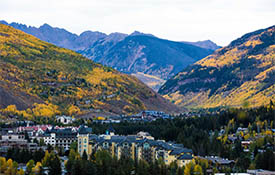SAM Magazine—Denver, Nov. 21, 2017—The summer of 2017 set two all-time records for the six-month summer season—a strong seven percent gain in aggregated revenue among 20 mountain destinations in  eight western states, and occupancy eked out a scant 0.1 percent increase over the summer of 2016. The month of October was up 9.7 percent in occupancy with a 14.1 percent gain in revenues compared to October 2016. This is the final summer report for 2017 released by Inntopia in its monthly DestiMetrics Market Briefing.
eight western states, and occupancy eked out a scant 0.1 percent increase over the summer of 2016. The month of October was up 9.7 percent in occupancy with a 14.1 percent gain in revenues compared to October 2016. This is the final summer report for 2017 released by Inntopia in its monthly DestiMetrics Market Briefing.
The strong showing for October continued a years-long trend of increasing visits in what used to be the shoulder season.
“Even though summer occupancy was up only slightly, the strength of the consumer marketplace is apparent in strong rate increases that led to another summer revenue record,” said Tom Foley, vice president of business intelligence for Inntopia. “This trend of flat occupancy along with increasing daily rates started showing up last winter and persisted throughout the summer and is now evident in the winter data for November through April arrivals,” he pointed out.
As of Oct. 31, aggregated winter occupancy is down 0.1 percent compared to the same time last year with declines appearing in three of the six months—December, January, and March. In contrast, the Average Daily Rate (ADR) is up 4.9 percent and is showing gains in four of the six months. The combination of occupancy plus rate increase is resulting in a moderate revenue growth of 5.4 percent compared to last Oct. 31. December is the only month showing a decline in revenue, due in part to the 3.6 percent decrease in occupancy for that month.
“Despite several western destinations pushing back opening dates because of inconsistent snowfall, economic momentum is positive and the purely destination visitor who comes from afar, books earlier, and stays longer seems undeterred,” explained Foley. “These destination guests are less concerned about snow conditions than local and regional visitors and are booking at a similar pace to last year, even with daily rates continuing to edge up.”
“As we move into the peak booking months for mountain resorts, what remains unclear is whether occupancy is flattening because some properties and regions are nearing capacity or if the increasing rates are dissuading some visitors from booking,” mused Foley. “At this point, we suspect it is a combination of both scenarios although some other unidentified variable may be in play. But, at this point, what is clear is that this pattern has persisted for 10 consecutive months so an immediate upward jump in occupancy isn’t likely without a ‘perfect storm’ of rate declines and significant, marketable snowfall,” cautioned Foley.




